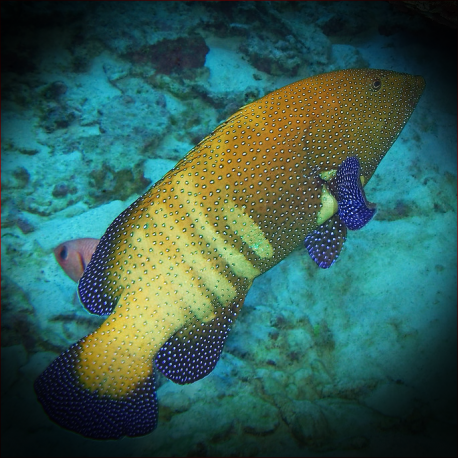More info
Datasheet
| Minimum Tank Size | 945 litres / 249.64 US gallons |
| Maximum Size | 10.2cm / 4.02inches |
| Reef Compatible | With Caution |
| Temperament | Aggressive |
| Care Description | Moderate |
| Specific Gravity | 1.020-1.025 |
| Carbonate Hardness | 8-12 |
| pH | 8.1-8.4 |
General Description
The Blue Dot Grouper, also known as Bluespotted Grouper, Argus Grouper, or Peacock Hind, displays a mottled brown coloration with dark fins and distinctive light blue dots covering its entire body. Additionally, the posterior part of its body showcases six vertical bands of white, adding to its striking appearance.
Aquarium Suitability
With a moderate level of care, the Blue Dot Grouper requires a sizeable aquarium of at least 250 gallons due to its significant size and feeding behavior. It is crucial to note that this fish exhibits extreme aggressiveness and may prey on both tank mates and crustaceans, necessitating careful consideration when selecting suitable companions.
Demands
Preferring a carnivorous diet, this species of grouper thrives on meaty foods such as krill, shrimp, and other small fish. Maintaining water conditions within specific parameters of a pH range of 8.1-8.4, a salinity level of 1.020-1.025, and a carbonate hardness (KH) of 8-12 is essential for its well-being.
Care and Hardiness
Due to its aggressive temperament, the Blue Dot Grouper requires attentive care to ensure the safety of other tank inhabitants. Providing adequate space, appropriate tank mates, and a suitable diet are crucial aspects of maintaining the health and well-being of this species in a captive environment.
Reef Suitability
Considered reef-compatible with caution, the Blue Dot Grouper can be housed in a reef aquarium; however, close monitoring is necessary to prevent it from preying on smaller reef inhabitants.
Aquarium Setup
Creating a suitable environment for the Blue Dot Grouper involves setting up a spacious aquarium with ample hiding spots and areas for exploration. Additionally, ensuring a secure lid is essential to prevent this aggressive fish from attempting to escape.
Behaviour
Known for its aggressive behavior, this grouper species may exhibit territorial tendencies and aggressiveness towards other fish. Monitoring its interactions with tankmates is crucial to prevent any potential conflicts.
Feeding and Diet
As a carnivorous species, the Blue Dot Grouper thrives on a diet rich in meaty foods, including krill, shrimp, and small fish. Offering a varied and nutritious diet is key to maintaining the health and vitality of this fish in captivity.
Habitat and Distribution
The Blue Dot Grouper, scientifically known as Cephalopholis argus, is native to tropical waters and can be found in the Indo-Pacific region. Its natural habitat includes coral reefs, rocky crevices, and areas with ample hiding spots for protection.

